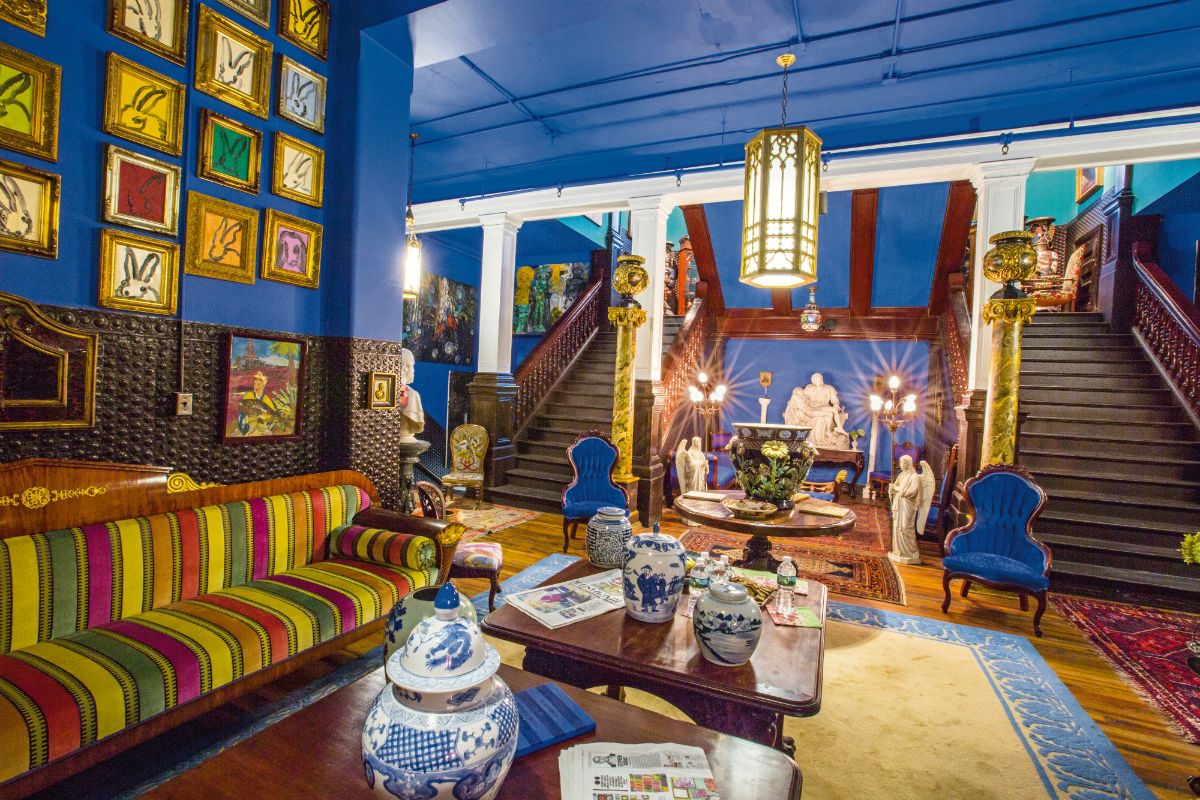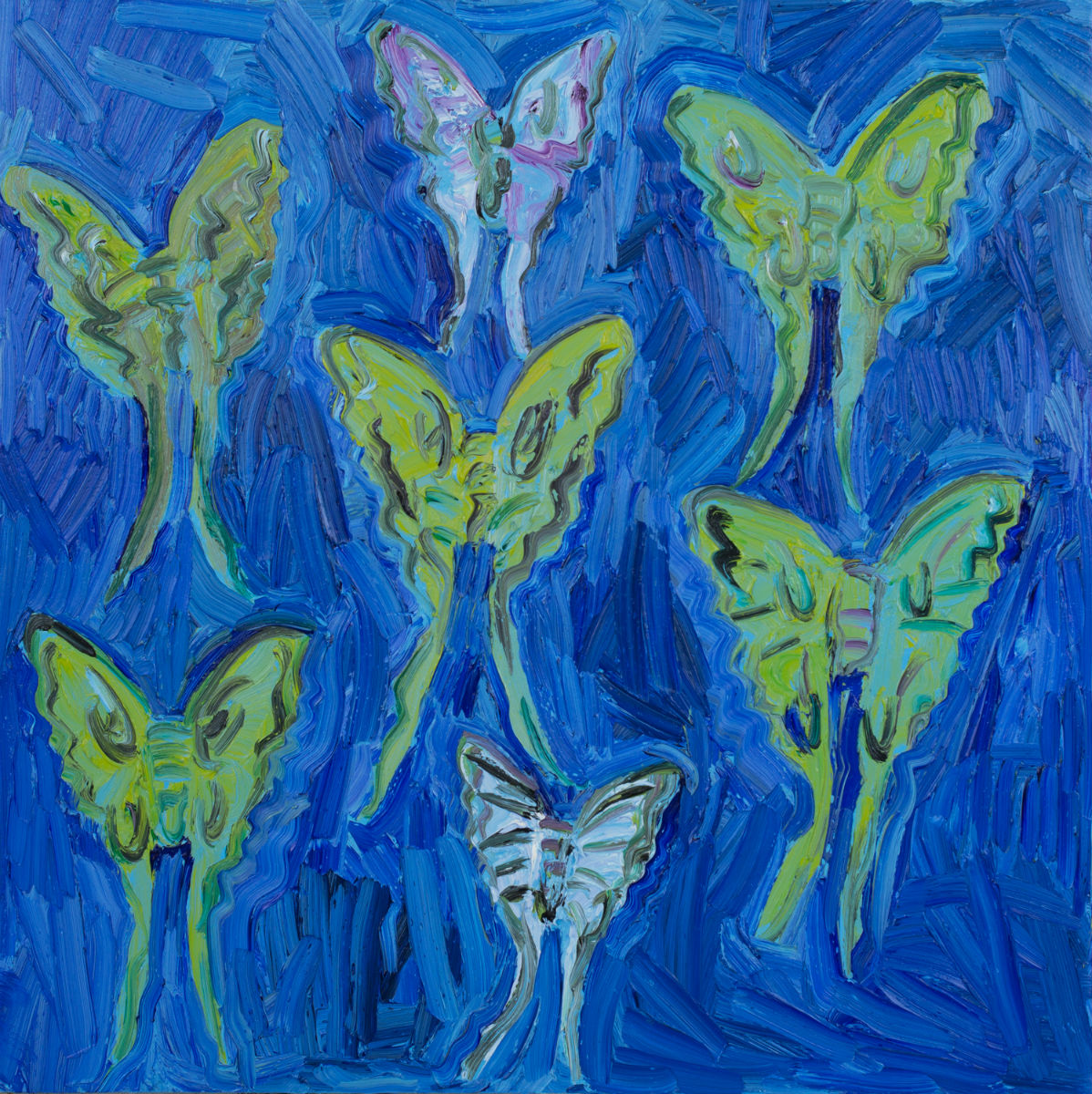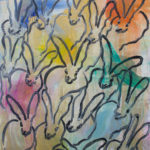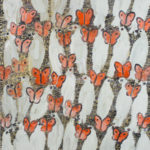
Hunt Slonem’s creative journey is a profound celebration of life’s interwoven layers—nature’s transient beauty, cultural heritage, and the spiritual essence of art. Recognized globally for his distinct neo-expressionist style, Slonem’s works are housed in the permanent collections of over 250 esteemed institutions, including the Solomon R. Guggenheim Museum, the Metropolitan Museum of Art, and the Whitney Museum.
Slonem’s artistic philosophy emerges from a deep spiritual and ecological consciousness. Inspired by his upbringing amidst Hawaii’s lush tropics and his formative experiences in Central America, Slonem’s work reflects a meditative reverence for nature’s rhythms and the vibrancy of biodiversity. His recurring subjects—rabbits, birds, and butterflies—are not merely motifs but spiritual totems that evoke the ephemeral and the eternal. With gestural brushstrokes and richly textured surfaces, his pieces transform simplicity into profound visual and emotional dialogues.
Hunt’s art is deeply rooted in the traditions of German Expressionism, while remaining uniquely his own. Scholars and critics, including Henry Geldzahler and John Ashbery, have described his work as both spiritually evocative and visually dynamic, embodying an “esthetic of ocular activity” that invites the viewer’s eye to wander and decode layered compositions.
Beyond his canvases, Slonem’s passions extend to the preservation of history and architecture. His dedication to restoring forgotten historic buildings reflects his belief in the power of space to hold memory and meaning. From Louisiana’s Albania Plantation to the Scranton Armory in Pennsylvania, Slonem’s restoration projects embody his holistic approach to creativity—melding art, history, and community.
Slonem’s oeuvre and ethos have been captured in numerous publications, including Bunnies (2014) and When Art Meets Design (2014). Each book offers a glimpse into his richly layered world, where art, history, and the natural world converge into a tapestry of wonder and discovery.
For Hunt Slonem, life and art are inseparable—a perpetual celebration of color, texture, and spirit. His work continues to inspire a profound connection to the world around us, encouraging reflection on both its fleeting beauty and enduring resonance.
Interview
Artist: Hunt Slonem
The early years of people’s lives are often crucial for their emotional, intellectual, and perhaps creative developments. Your father was a Naval Officer, and this meant you had a nomadic childhood. How, if at all, did living and traveling to different places inspire you? What memories do you carry of those places and experiences? How have your travels affected or colored your work?
I was conceived in Boston, born in Maine. My father went to Annapolis and MIT. He was in submarines and there were only certain places we could live, the most exotic of which was Hawaii, which affected me enormously as a child. I used to go to the Bishop Museum and look at the king’s cloaks that took 300 years to make with the tail feathers of the mamo bird. In fact, I had a catalog entitled “The Bare Bottomed Mamo.” I’ve done feather installations with my work. I live with 50 birds and I save their molted feathers and do feather room projects with them.
The colors and movement and native dances of Hawaii were overwhelmingly inspiring to me. I grew cattleya orchids as a child, I had pet birds, I would catch tropical fish in the sugarcane field ponds, and I would walk through the rain forest all the time. We had neighbors from every corner of the earth -Samoa, Fiji, Japan. I was very blessed to have that experience very early on. The whole quality of my life which I’ve referred to as “exotica” was first formed there.
Hawaii was very formative. Later we lived in California, Washington State, Virginia, New Hampshire, California…quite a few places. When I was a high school exchange student attending Colegio Centro América in Managua, Nicaragua, I used to have the chauffeur drop me off in the jungles to collect butterflies and observe nature. It was the most exotic thing imaginable. We went in boats to Bluefields and we would go to the coffee plantations and see millions of butterflies perched alongside the water sipping. I mean every form and color imaginable was displayed!
I loved the family I lived with in Nicaragua. Doña Lourdes at Casa de Mallorca. They had a lot of children and it was like 100 Years of Solitude. It was this whole other world from the 19th Century. There was a head servant named Raphaela, a cook whose name I can’t remember, and a big parrot in the courtyard outside the kitchen. The 95 year old grandfather had been in Paris in his youth, now lived in a 300 year-old house in Leon. The house was filled with the fragrance of jasmine in the evening. On his birthday, everybody who was important came to the house – the clergy, the president, women on one side of the house, men on the other side. I can’t imagine that experience existing anymore. I remember the house was built around two enormous courtyards, and when you sat in the dining room a family of turtles would walk out every day into the sun while you were eating. It was great.
I experienced toucans and other birds for the first time. It was an expansive experience and I came home very changed. You know, my world just was turned on to color, a stark contrast to a kind of boring American suburban life, although we did live in a wonderful house when I was in high school, that was built in 1895.
My great-grandfather’s house in Tennessee was torn down six months before I was born. Between that, and Picasso’s habit of buying chateaus, filling them up and locking the door, I was very turned on to the idea of saving these great old enormous houses, filling them up and treating them as my art form. Aside from the painting, this installation and saving national landmarks is my passion. I’ve just bought Henry Howard’s masterpiece Madewood Plantation. It’s a huge challenge to restore and save these buildings, but it’s great.

How did you adopt the cross-hatching technique?
I had lived in my studio with a 40-foot bird cage for 24 years, and I wanted to paint the birds more specifically. I just picked up the back of the brush and started making the marks of the grid into the paint, and then later I started carving the brush. I started painting wet into wet, which I had never done. I came across it without any advice. I wasn’t copying anyone, that I was aware of. It just happened so magically and spontaneously and has continued to this day.30 years of making marks into paint. A lot of people think I use a rake, but I carve the back of the brush and I make each mark, one at a time, by hand, with no help. I thought that was a realist technique. I was trying to just show the cage, because no matter what it was, I was looking at everything through this grid pattern. In my first review in The New York Times the author said that if Joseph Cornell painted, it would be very similar to what I do, because he used mesh, and birds, and mark making. But it didn’t even occur to me until it was said.
What were your expectations when you moved to New York City in 1973? How do you think your work has evolved since then?
Well I came to New York because I went to the Skowhegan School of Painting and Sculpture in Maine. It was during my junior and senior year of college and there I met great artists. I had never been exposed to the real world of art and artists who could make livings, and become a big deal, and influence the world. That dynamism just grabbed me. I was encouraged. I got a grant to BAM School of Fine Art after I graduated from college. I was so impressed by Skowhegan, but that became less impressive to me, probably because I’d gone to high school in Washington State and I’m not into mountains, and (at Skowhegan) I was surrounded by them. So, I got on a bus, moved to New York, and struggled forever. I did everything from wait on tables, to sort mail, to you name it. I was about to leave after five years when finally, I was hired under the Cultural Council Foundation Artist’s Project where we did public art for two years. I was selected and did a huge mural at the World Trade Center. I did saints for churches in Brooklyn. Then I was awarded a few grants. One from the Greenshields Foundation in Montreal. Canada’s been very good to me over the years.
How my work has evolved? I started out painting landscapes and people. Then I got into a rather flat, still life period, very bright. I did a lot of silkscreen prints at that time. I was able to do big murals, which was wonderful. I was picked to do the Bryant Park Grill behind the New York Public Library at one point. The whole thing really changed in the ’80s. About 1984, after my trips to India, I had been painting. Everything came out of my early saint paintings. I had rabbits in them, I had butterflies, I had birds, and then I had a figure of saints with New World connections, like St. Martin de Porres, St. Rose of Lima, Santo Niño de Atocha. I did a huge painting called “Seven Saints.” There was a flurry of activity in Religious Art, and I was on the cover of the arts and leisure section of The New York Times with a painting of mine, of St. Martin de Porres.
I started to then leave the figure out and isolate the elements that were in those things. So, the rabbit paintings became studies at first. Now the studies have turned into installing a hundred small works in frames. It is a kind of reference to the gilded cage. I collect old frames. Shopping has always been a big part of my art.
In my use of color and showing of animals, I’m saying, “You know, take a good look. They’re disappearing from our world.” Many animals are already extinct, even more recently in our lifetime, so it’s a reminder of the beauty of other worlds that has been bestowed on earth for whatever time we allow it to continue. You know the Amazon Jungles took 60 million years of evolution to arrive at these life forms, and we’re knocking them down. There’s a famous quote about a species, that a bulldozer driver is the only one in the history of the world that will ever see it, because he’s destroying their breeding ground. There are so many tragedies like that going on. I’m a reminder to revere nature. That used to be a sacred thing. In ancient days they took one or two feathers for the king’s crowns, and whatnot and released the bird. But if you killed the quetzal bird, you were killed.


You are involved in many different social causes. How did the project with the Ronald McDonald House on Long Island come about? What was the impetus for your idea of discovering and revitalizing often forgotten and neglected historic buildings?
I’m asked to give to charities constantly, which is great. As you know I love historic preservation, for which there’s no money, other than private funding if they can even find that. I’m involved with Alzheimer’s, my mother has it, and with many animal organizations. I donate art to help raise money and awareness for all these different projects. Children and art education are a big one for me too, because we don’t teach art in schools, and I wouldn’t be an artist if they hadn’t taught it when I was a child. The Ronald McDonald House was something I was asked to do through Lee Jofa. I make fabric and wallpaper and Lee Jofa wallpapered part of the Ronald McDonald House which got a lot of attention for them.
I bought my first house about 17 years ago, right before 9/11 on August 17. A lot of my friends were moving to Hudson and they said, “Oh, come and look.” I said, “I hate the country, I’m not interested.” We went up and I saw a few Second Empire houses. I said if there’s ever one of these available, let me know. Some friends had me call their realtor and he sent me a picture of the Courts Mansion and I just fell in love with it.
I talk to psychics a lot and they told me I was buying these things. In fact, with the plantation houses, they said, “You’re buying a plantation in Louisiana. This is what it looks like. This is its position to the water.” And I said, “I don’t want one, I want a house in New Orleans maybe. But I love Antebellum architecture.”
Anyway, somebody from Dubai came and bought out my show in New Orleans and a friend said, “Get in the car, Miss Emily’s dead, we’re going to Albania.” I flipped out over this house (the Albania Plantation), bought it, and it’s been in a constant state of restoration, which is fabulous.
They all have very interesting histories. Lakeside was once owned by the Marquis de Lafayette during the time of the Louisiana Purchase. But I’m also trying to pump new life into these great historic buildings. They’ve all been settings for films. We had “All the Kings Men” shot in Albania; “Beautiful Creatures” with Jeremy Irons at Lakeside; Nicole Kidman in “Beguiled” at Madewood; and Beyonce did her music video, “Lollipop” there. It’s a fun, nice thing to see what we’ve done with these properties used in different forms. People come and tour sometimes.
I bought a house recently called Beltaire, which was built by a Scottish copper baron. I find things wherever I go or perhaps they find me, and it’s all through my art. I can’t bear to let these things collapse.

Credit: Chris Balton

Credit: Chris Balton
Your jungle-like studio in Brooklyn has some 60 exotic birds. Do you have a favorite one? Have you named each one? What was your first pet?
They all have names. Most of them have been given to me. They’re all unwanted pets, so I’m like a rescue. I don’t have 60 at this time, I have less than that, but I’ve had many more at other times. I have a wonderful pet named Perky, an Amazon who speaks constantly and is very affectionate. I have another one that’s 75 called Sebastian. Each has a huge personality, and they all are great companions. They don’t get along with each other always, and they’re very noisy, but I’m hooked, and I can’t do without them. They’re great companions for a painter.
Your name is a global brand and you work as a sculptor, painter, printmaker, designer, and luxury real estate developer and investor. How do those things complement or compete with one another? What role do you identify with, feel most comfortable with?
I’m not a luxury real estate developer. I am a savior of collapsing national landmark houses, of great houses with historic credibility and interesting architecture. I have never sold a house.
I feel comfortable with all of it. Some of it is a newer like the books. I wasn’t publishing books, but the houses led to the books. The houses led to movies. The houses led to collections. Most artists that I like have left wonderful collections and wonderful studios. I think the artists’ homes and studios are of utmost interest. I think for example Gustave Moreau Museum is phenomenal and Giverny, there are so many great artists’ houses. There’s a great book called “Where Muses Dwell,” an overview of the history of artists’ homes, and it’s such a reflection and integral part of the artist’s expression. That hopefully, is what I’m going to leave as a foundation, that’s my goal.

Credit: Chris Balton

Credit: Chris Balton

Credit: Chris Balton
After living in so many places, what about New York has kept you anchored here?
It’s almost impossible to leave New York. I don’t think I went out of the city once in my first nine years, I was always afraid I would miss something. One gets worn out after a while. I’ve been here since 1973, and I greatly look forward to my travels and having homes away from New York and in other climates. You know, I just came back from my shows in Dubai, where we rode camels, and had fun, and it’s great. And I go to Louisiana every month, where I work on sculpture, and I work on my homes, and I gather ideas for painting. It’s all a very complete statement, one breath of expression in a myriad of forms.
The people in New York are phenomenal. I love the people. Everybody’s so interesting and informed. People are aware of things before they are in other places. I find when I leave town the frame of reference is not as enormous in terms of certain things that are going on and maybe bigger in other ways, agriculture, politics, whatever. But in New York, for me, it’s just the epitome of what’s being promoted. It tends to happen first here. It’s inspirational in its energies, everything seems to be centered here.

Which painting, or work has given you the most satisfaction?
The one I’m working on that day. I’m always excited about what I’m doing in the moment. Highlights of my career have been maybe large things that I’ve done. I’ve done some very large projects. I just completed a hundred foot painting. I’ve done installation projects in museums recently that were very exciting and a new level of involvement in what I’m trying to say. So, the new, what’s new. I don’t rest on my laurels if there are any.
What is the best and worst advice you ever received in your art career?
The first piece of advice I received from my parents was don’t be an artist.
The second and best piece of advice was from Alex Katz who once said you’re never ready to show. And Philip Pearlstein at Skowhegan said, persist, never give up. He applied for a Fulbright for 16 years in a row. So just never give up.


Looking back over your career, would you change anything if you could start over?
I don’t want to start over with anything. It’s too hard. I don’t think you can change it. You’re just in the moment. I don’t calculate things; you make choices based on what is offered at that time. I kind of believe in destiny almost.
What do you hope is your legacy as an artist?
Well I like to heal and uplift people. I mean my favorite thing is to have my work lined up in hospitals and museums and whatever. I have great pride in the collection. But I like simple, wonderful things for example when pregnant women come to me and get a bunny, then when they have their baby, they hang the bunny in front of the crib, and the little baby is waving at the bunny. I feel like I have some impact on people’s lives no matter how big or small.
I want to look at what’s great on this planet rather than the struggles and political problems. I want to be in an exulted place with consciousness not a tortured, anxious place. Not that I’m not, but I want my work to be in that place. I just do it. It’s channeled through me and I feel that it’s relevant to society. I mean people seem to gravitate towards certain images that I make.



STUDIO CONTACT
212 620 4835
HUNT@HUNTSLONEM.COM













































